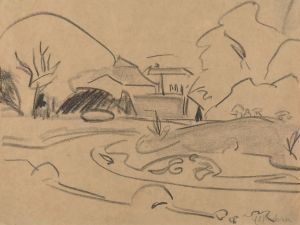
Sketch for Pavilion Near a Mosque
A hand-painted replica of Félix Ziem’s masterpiece Sketch for Pavilion Near a Mosque, meticulously crafted by professional artists to capture the true essence of the original. Each piece is created with museum-quality canvas and rare mineral pigments, carefully painted by experienced artists with delicate brushstrokes and rich, layered colors to perfectly recreate the texture of the original artwork. Unlike machine-printed reproductions, this hand-painted version brings the painting to life, infused with the artist’s emotions and skill in every stroke. Whether for personal collection or home decoration, it instantly elevates the artistic atmosphere of any space.
Félix Ziem was a French painter associated with the Barbizon School and is known for his vibrant landscapes and cityscapes. One of his works, "Sketch for Pavilion Near a Mosque," reflects his interest in capturing the essence of different locales, particularly those with an exotic or oriental flair, which was a popular theme among European artists in the 19th century.
Ziem was born on February 26, 1821, in Beaune, France. He initially trained as an architect before turning to painting, a decision that would lead him to travel extensively throughout Europe and the Near East. His travels greatly influenced his artistic style and subject matter, and he became particularly known for his depictions of Venice and Constantinople (modern-day Istanbul).
"Sketch for Pavilion Near a Mosque" is a testament to Ziem's fascination with the architecture and atmosphere of the Eastern Mediterranean and the Islamic world. Although specific details about this particular sketch are limited, it is consistent with Ziem's broader body of work, which often includes architectural elements such as mosques, pavilions, and other structures that convey a sense of place and cultural identity.
Ziem's technique often involved the use of vivid colors and dynamic compositions, which helped to convey the light and atmosphere of the scenes he depicted. His sketches and paintings are characterized by their loose brushwork and an impressionistic approach to capturing light and shadow. This style allowed him to convey the vibrancy and energy of the locations he painted, drawing viewers into the scene.
Throughout his career, Ziem was celebrated for his ability to capture the spirit of the places he visited. He exhibited regularly at the Paris Salon, where his works were well-received by both critics and the public. In 1857, he was awarded the prestigious Legion of Honor, a testament to his contributions to French art.
Ziem's work, including "Sketch for Pavilion Near a Mosque," is part of a broader tradition of Orientalism in 19th-century European art. Orientalism refers to the depiction of Eastern societies and cultures by Western artists, often characterized by romanticized and exoticized portrayals. While this movement has been critiqued for its stereotypical representations, it also reflects the fascination and curiosity that many Western artists and audiences had for the East during this period.
Today, Ziem's works are held in numerous public and private collections around the world. His ability to capture the essence of diverse locales continues to be appreciated by art enthusiasts and scholars alike. "Sketch for Pavilion Near a Mosque," like many of his works, serves as a window into the artist's travels and his enduring interest in the interplay between architecture, culture, and the natural environment.
In summary, Félix Ziem's "Sketch for Pavilion Near a Mosque" exemplifies the artist's skill in capturing the unique atmosphere of the places he visited. Through his use of color, composition, and light, Ziem invites viewers to experience the beauty and intrigue of the Eastern Mediterranean and its architectural heritage.






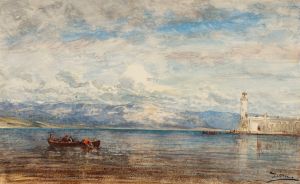
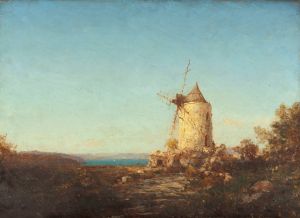
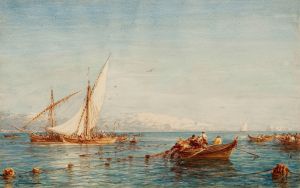
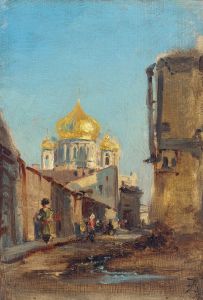

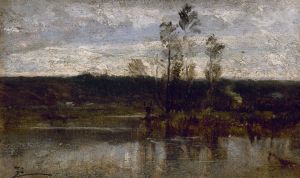
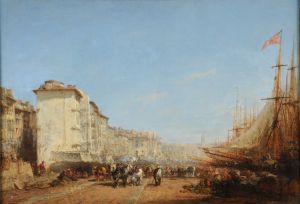
![Design for dčor of restaurant, 56 East 56th St, New York, NY.] [Drawing of suggested dčor for restaurant with color elevation and murals](/imgs/249282/s/winold-reiss-design-for-dcor-of-restaurant-56-east-56th-st-new-york-ny-drawing-of-suggested-dcor-for-restaurant-with-color-elevation-and-murals-29535340.jpg)
![Drawings for proposed decorations of Mike Lyman’s Restaurant, 424 W. Sixth St., Los Angeles, CA.] [Drawing #7, playroom elevation L and bar elevation M](/imgs/249338/s/winold-reiss-drawings-for-proposed-decorations-of-mike-lymans-restaurant-424-w-sixth-st-los-angeles-ca-drawing-7-playroom-elevation-l-and-bar-elevation-m-f9ee50d2.jpg)
![Drawings for proposed decorations of Mike Lyman’s Restaurant, 424 W. Sixth St., Los Angeles, CA.] [Drawing #10, Scheme 1; Color scheme for ceiling – main dining room](/imgs/249426/s/winold-reiss-drawings-for-proposed-decorations-of-mike-lymans-restaurant-424-w-sixth-st-los-angeles-ca-drawing-10-scheme-1-color-scheme-for-ceiling-main-dining-room-6113fb5a.jpg)
